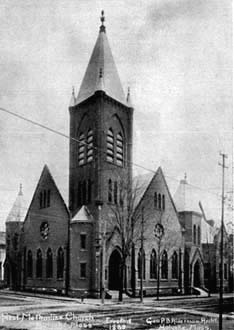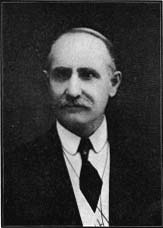|
History of Holyoke's Churches
The First Methodist
Rev. O.W. Hutchinson, Pastor
The First Methodist Church acknowledges the South Hadley Falls Methodist Episcopal Church as the mother of Methodism in Holyoke. The preachers from that church, Rev. Freeman Nutting, Rev. E.S. Best, and other pioneer preachers, occasionally preached in Holyoke prior to 1853, and a class had been organized. Rev. Thomas Marcy, superintendent of public schools in Northampton, and a member of New England Conference, commenced regular preaching services in Lyceum Hall on High street early in 1853. 
First Methodist Church
In May, 1853, the church organized, consisting of twenty members. Soon after they removed to Gallander & Terry's Hall on High street where they remained until 1857. Then they moved to Chapin Hall, where they remained until they occupied their own vestry in the new church on Main street, July 4, 1869. This church, like all the Methodist churches in New England, had to make a heroic struggle for existence. Rev. Thomas Marcy, after a year of successful service, was followed by Rev. Rodney Gage, and he by Rev. Philander Wallingford, each serving a year. Rev. M.E. Wright was the first to remain two years. Owing to business depression and the removal of many members, Rev. M.E. Wright advised the church to disband and unite with other churches. Some of the members did this, but a heroic few, with more faith and courage, maintained their organization amid those discouragements. Rev. Martin Chapin, a local preacher living in Florence, and a former resident of Holyoke, came to the rescue of this struggling church, offering to supply the pulpit "without stated remuneration." This he continued to do for two years. In 1860 the Rev. Nathaniel Fellows, just graduated from Weseyan University, was stationed here by the New England Conference. The church enjoyed a prosperous season under his two years' pastorate. Following him Rev. William J. Hambleton and Rev. William D. Bridge each served a year. Rev. John Peterson was the first to serve this church for three years. During his prosperous pastorate the Water Power Company kindly donated the land on the corner of Main and Appleton streets for a new church. In 1865 the foundations for the new church were laid on this site, but a lack of funds compelled the society of suspend operations for three years. Rev. Samuel Roy — a grand preacher — followed Rev. Mr. Peterson, but remained only a year. In 1868 Rev. I.B. Bigelow, an experienced church building and a good preacher was appointed to this charge. This was a marked pastorate. By his example, he inspired the people with faith, courage and the spirit of consecration. The church building enterprise was resumed. In 1869 the vestry was ready for occupancy, and the auditorium in the spring following. The church was dedicated in March 1870, Rev. I.G. Bidwell, D.D., and Rev. George Whitaker preaching the sermons. This first church with furnishings, cost without the land, $16,000, and was dedicated with only $2,700 debt upon it. Great credit was due Rev. I.B. Bigelow and the noble band that stood beside him in that enterprise. 
Rev. O.W. Hutchinson
Rev. T.J. Abbott followed Rev. I.B. Bigelow, enjoying two prosperous years. Rev. W.N. Richardson served from 1873 to 1875, Rev. C.A. Merrill during 1876 and 1877, Rev. William Gordon in 1878 and 1879, Rev. E.A. Titus the three years following. Rev. E.P. King was stationed here in 1883. During his three years' pastorate a delightful revival spirit prevailed. The debt on the old church was entirely liquidated, and a chapel was built at the Highlands at a cost of $4,000, on land donated by James Allyn. This chapel has since become the Highlands Methodist Episcopal Church. For three years this was a mission of the First Church and the pulpit was regularly supplied Sunday afternoons by the pastor of the First Church. In 1886 Rev. G.C. Osgood followed Rev. E.P. King. For years there had been a growing conviction that the location of the church ought to be changed. The growth of the city had been away from the church. After long and prayerful deliberation, the trustees borrowed money, and in February, 1887, bought for $10,000 the present location on Appleton street. The following Sabbath Rev. Mr. Osgood presented the matter to his congregation and $4,000 was subscribed in a few moments. In November, 1887, the congregation subscribed $2,200 more. In May, 1889, the Quarterly Conference authorized the trustees to proceed and build a new church. J.M. Dunham, S.F. Barrett, and Charles C. Thorpe were appointed a building committee. A lot was purchased on Beech street, and the parsonage removed to that location and thoroughly renovated, the whole costing $4,000, but giving to the society a parsonage worth $7,000. Plans for the new church were made by G.P.B. Alderman. The cornerstone was publicly laid October 2, 1889, a large company of clergymen assisting, including the pastors of the Congregational churches — Rev. E.A. Reed, D.D., and Rev. G.W. Winch — and Rev. C.H. Kimball, then pastor of the Second Baptist Church. On June 25, 1890, the church was dedicated by Bishop E.G. Andrews of New York; the evening sermon was preached by Rev. F. Woods of Westfield. The church is built of brick with East Longmeadow stone trimmings; its dimensions are 76x114 feet. The chapel is at the right of the auditorium and connecting with it by folding doors. The entire seating capacity is 950. Over the chapel are the social rooms, consisting of ladies' parlor, dining rooms, kitchen, cloak room, etc. The entire cost of the church was $42,000; church and parsonage $49,215. The indebtedness at the day of dedication was $34,945, allowing that the unpaid subscriptions amounting to $2,639 were reliable, with the old church property as an offset. In 1891, when Rev. William E. Knox was appointed to this charge, the debt with accrued interest amounted to $39,500. During his five years' pastorate Rev. W.E. Knox reduced the debt to $14,000. Of the amount paid, $12,150 was realized from the sale of the old church. The church will never forget the great work accomplished by Rev. W.E. Knox during his five years' pastorate. In April 1896, Rev. N.B. Fisk was appointed pastor and for two years rendeded faithful and efficient service, while Rev. Henry L. Wriston entered upon his labors in 1898 and was notably successful, both at reducing the debt and in recruiting new members. Rev. J.P. Kennedy served the church as pastor from 1902-1909—the longest pastorate the church has enjoyed. He relinquished the pastorate to become superintendent of the Springfield District. Ever since the dedication of the Appleton street building a heavy debt had rested upon the property. Through the efforts of Revs. W.E. Knox and H.L. Wriston this debt was reduced to about $13,000. During Mr. Kennedy's pastorate this debt was entirely paid and the mortgage burned. Today the church owns property — church building and parsonage — worth about $65,000, entirely free of debt. It also owns a tenement on Beech street, which it rents, and holds trust funds of some $11,000 for the benefit of the needy. In April 1909, Rev. Oliver W. Hutchinson became pastor. In 1911 the chapel and Sunday school rooms were thoroughly renovated and redecorated. The church has just renovated its auditorium. Electric lights have been installed, a hard wood floor laid, the walls redecorated and other improvements made. The funds necessary for this work have already been subscribed and the work was done during the summer. The Sunday school has been thoroughly graded and reorganized and several large adult organized classes have been developed. The congregation and school have been increasing and the finances of the church were never in so satisfactory a condition as at present. The membership of the church is between 400 and 500, well scattered over the city, owing to the location of the church; also there is a considerable non-resident membership. There is an Epworth League of about 70 members, a Ladies' Aid Society, a Woman's Foreign Missionary Society, the Standard Bearers, and the Methodist Brotherhood, all doing vigorous work. In the earnest words of its pastor: "This church stands for the highest type of New Testament life and experience, aiming to maintain the evangelistic spirit of the gospel as taught by the great founder of Methodism—John Wesley. It also aims to improve civic and social conditions, and believes that the liquor traffic can never be licensed without sin. It declares the fundamentalist principles upon which all civic and social reforms must rest, but does not, as an organization, enter politics. It emphatically believes in the principles upon which American institutions rest—equality before the law, the free public schools for all Americans, and the Golden Rule for both labor and capital. It would comfort the sorrowing, encourage the weak, reclaim the sinning, and strengthen the forces of righteousness in all departments of life. Its spirit is hopeful, for it believes in the ultimate triumph of the principles for which it stands." Officers: Resident Bishop, Rev. J.W. Hamilton, Boston, Mass; district superintendent, Rev. Joseph P. Kennedy, D.D., Holyoke; pastor, Rev. Oliver W. Hutchinson, 169 Beech street; board of trustees, C.R. Alger, S.C. Barrett, N.C. Cook, C.S. Davis, Thomas McGuines, J.H. Montgomery, William H. Parfitt, Lucius Person, John Stalker; stewards, R.B. Corbitt, Edward Cramer, G.W. Burch, Robert Gilette, Charles House, C.W. Haworth, Fred E. Miner, Lawrence R. Miner, Harry S. Johnson, John P. Reed, Charles Short, Robert J. Wood, Albert Webb; class leaders, John P. Reed, John Stalker; Sunday school superintendent, Henry Butcher; Ladies' Aid Society, Mrs. A.H. Glynn, president; Methodist Brotherhood, B.G. Simpson, president; Epworth League, Lee H. Brow, president; Woman's Foreign Missionary Society, Mrs. W.R. Sanderson, president; Standard Bearers, Miss Ada J. Smith, president; church treasurer, Thomas McGuines; financial secretary, Robert Gilette; treasurer of benevolence, Mrs. R.J. Wood; sexton, Scott F. Barrett, 63 West street.
| People & Organizations | Allyn's Sketch of Holyoke |
| Selected Advertisments | Churches | Surname Index |
© Laurel O'Donnell 1996 - 2005, all rights reserved
This document may be downloaded for personal non-commercial use only and should not be reproduced or distributed without permission. |